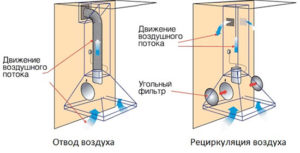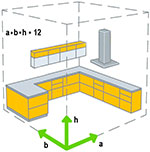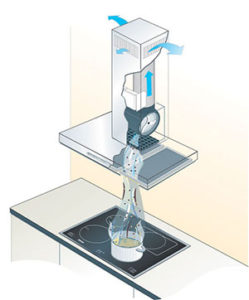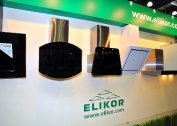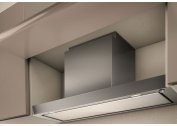The main task of any kitchen hood is to clean the room air from various odors, remove soot and grease from it, which settle on the furniture. Any kitchen, regardless of its size, needs a hood, this device will be especially relevant if this room is combined with a dining room or some other part of the home.
Before buying such a household appliance, it is important to correctly determine the required hood power - it is this parameter that determines how well it can cope with its tasks.
What hoods and their modes of operation exist
Before selecting a model suitable for its power, the hood to the kitchen is first of all selected by design. Depending on this, there are:
- built-in models - mounted directly inside the hanging cabinet so that only the filter grate for trapping fat is visible from the outside;
- wall-mounted models - are attached directly to the wall above the stove, can be installed under a hanging cabinet or instead of it;
- island type - mounted to the ceiling, usually designed for a kitchen that has a non-standard layout;
- models of an angular type - are intended only for installation in a corner of the room.
Regardless of the design of the hood, it can function in one of two modes:
- exhaust;
- recirculating.
Exhaust - from the air a grease filter removes particles of fat, after which it is removed from the apartment through the ventilation system. For the device to operate in this mode, an air duct and fresh air are required.
Recirculation - fat is removed from the air mixture along with unpleasant odors. For this, in addition to the grease trap, the device also has a charcoal filter. Upon completion of the cleaning, the air again enters the kitchen.
Classic power detection
Most often, when choosing the optimal power of a kitchen hood, the following formula is used: you need to determine the volume of the kitchen and multiply it by 10 or 12 - just as many times per hour of using the stove, a high-quality hood completely replaces the entire air mixture from the kitchen.
However, this option for calculating the required power is very generalized, since it does not take into account any nuances of the kitchen and the conditions for using the hood. Therefore, this formula requires some adjustments.
First of all, it should be borne in mind that a factor of 10-12 allows you to determine the power level of equipment at the maximum speed of its operation. Therefore, making a choice in this way, there is no power left in case of unforeseen situations. Thus, in the case of such a choice, the hood will always have to work at maximum speed, which will lead to excessive noise, and the life of the device will be significantly reduced.
In addition, the calculation coefficient must be changed depending on the type of hob used. For example, for electric stoves, a coefficient of 15 is required, and for gas stoves, in general, 20, since the products of gas combustion are also added to various fumes.
It should also be remembered that when taking into account the area, one should consider the area of the room, limited by windows, walls and doors. So, if in the kitchen instead of doors there is an arch, then when calculating the area taken into account is the kitchen itself and the room combined with it.
Thus, the classical calculation formula gives only an approximate idea of the minimum performance and hood power for the kitchen.If the model you like has less power than the calculated one or exactly the same, you should not buy this model, since it will not be a functional range hood, but just a useless noisy unit.
Calculation depending on the operating mode
In the case of choosing a hood that will operate in an exhaust mode, to determine the optimal power level, it is more correct to take into account not the kitchen volume, as is often advised, but the area of the ventilation ducts of the house.
In most cases, in modern homes, the diameter of the ducts is up to 140 mm. A maximum of 400 cubic meters of air per hour can pass through such a channel. And if we take into account the irregularities of the channels themselves and their connections, then the throughput will be even less. Therefore, even acquiring the most powerful hood model, the efficiency of its operation will directly depend on the throughput of the ventilation channels: everything that they will not pass can be attributed to power losses.
In addition, if the duct is connected to the ventilation duct, natural ventilation will be impaired. Also, the hood, which is installed above the stove, is simply not able to remove or clean the polluted air from the ceiling itself, even in the case of its high power.
Therefore, the preferred option for our conditions is to purchase a recirculation hood. In the case of functioning in this mode, the exhaust power plays a much larger role, since air is not removed from the kitchen. Passing through the filter elements, the air will create increased pressure, as a result of which the performance of the device will drop.
Therefore, when choosing a hood that operates in this mode, you can use the classical formula to calculate the required power, taking into account the above nuances.
Models that work in this mode do not need to be connected to the ventilation system, which will not lead to disruption of the natural ventilation of the kitchen, and will not spoil the appearance of the room with duct ducts.
Some nuances of power calculation
Often, one may encounter a situation where inexperienced sellers of a household appliance store advise consumers to purchase the simplest and most low-power models of hoods in small kitchens, the performance of which is simply primitive. This is a huge misconception: in a small room, the concentration of fumes and fat is much higher in comparison with spacious kitchens. That is why such rooms require a hood with good performance.
When choosing a hood that is suitable for its power, it should be remembered that such a installation is not a replacement for the ventilation system. Its main purpose is to remove the spent air mixture from the area above the hob, and not to clean the air in the kitchen or replace it with fresh air from the street.
And finally, one should never forget that, regardless of the power of the exhaust equipment for the kitchen, its width should never be smaller than the stove over which such a device is installed: at least, the hood should be exactly the same as the stove, and even better if it is wider than the hob.
Thus, the choice of the optimal hood model for the kitchen by the level of its power is a rather troublesome task, since you have to take into account many nuances. But now every consumer knows exactly how to choose the right power and hood performance for their kitchen.
